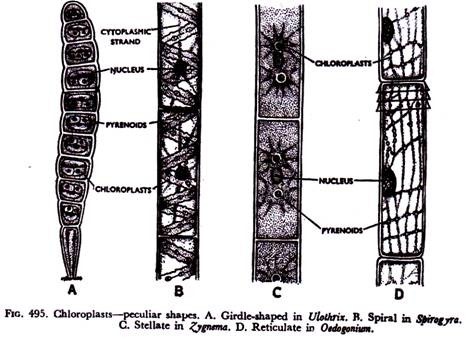Read this article to learn about Saccharomyces: Structure, Nutrition and Life Cycle !
Kingdom – Mycota – Division – Eumycota
Sub- division – Ascomycotina – Class – Hemiascomycetes
Order – Endomycetales – Family – Saccharomycetaceae
Genus – Saccharomyces – Species – cerevisiae
Saccharomyces or Yeast is saprophytic unicellular eukaryotic fungus which grows on sugary solution, grapes etc.
Structure of Saccharomyces:
In a culture of Saccharomyces 2 types of somatic cells can be seen
(a) ‘Dwarf strain’ yeast cells:
They are small (3 x 2µm) haploid spherical yeast cells which exist in 2 opposite mating types (+ and – strains)
(b) ‘Large strain’ yeast cells:
They are comparatively larger (15 x I0 µm) diploid, ellipsoidal yeast cells. Structurally both strains of Saccharomyces are unicellular, uninucleate, hyaline, holocarpic, non-mycelial thallus. In a favourable sugary medium as many as 64 cells found temporarily connected to form a pseudomycelium. The cell surface has one concave birth scar and on e or many convex bud scars. Like a plant cell, it consists of protoplast surrounded by cell wall. Cell wall composed of glucan (30-40%), mannan (30%), proteins, lipids and chitin.
The granular cytoplasm contains various organelles and reserve foods (glycogen and oil globules). The centril cytoplasm (endoplasm) contains a large vacuole with a nucleus at one end. From nucleus fine dark staining strands extend around the vacuole. The vacuole enclosed by tonoplast and fills with solution of volutin composed of RNA, lipoprotein and poly-phosphate granules.
Nutrition:
Yeast cells are facultative aerobe. They contain Zymase (an enzyme complex) which brings about alcoholic fermentation when placed in sugar solution. Alcohol fermentation is ectothermic process which goes on rapidly in absence of oxygen. Fermentation process occurs inside the cell, as zymase confined within the cells, except invertase which can diffuse out of cell.
In the life cycle of Saccharomyces cereviceae alternation of generations seen where 2 types of vegetative individuals alternate with each other’s i.e. the ‘dwarf strain’ haploid yeasts ceils alternates with ‘large strain’ diploid yeast cells. The ‘dwarf stain’ cells represent haplophase or gametophyte phase while large strain’ cells are diplophase or sporophyte phase. Saccharomyces undergo asexual cycle in favourable period and sexual cycle under unfavourable period.
(a) Asexual cycle (budding):
Under favourable conditions both ‘dwarf strain’ cells and ‘large strain’ cells multiply by asexual process called budding. During the process, near one pole cell wall softens by enzymatic action as a result an outgrowth appears. The nucleus divides mitotically and passes one daughter nucleus along with a part of vacuole into the outgrowth. The outgrowth now known as a bud that enlarges, and then constricts as a young yeast cell from the parent. Rapid budding may form pseudomycellium (Fig. 6.9).
(b) Sexual cycle (Haplo- diplobiontic cycle):
Under unfavourable condition Saccharomyces cerevisiae undergo sexual cycle which is haplo-diplobiontic type. Here both haploid and diploid phases are equally represented. The haploid dwarf cells have two genetically distinct mating types or strains (+ and -) (Fig. 6.10).
The haploid dwarf cells of opposite strains function as gametangia and perform gametangial conjugation. It involves plasmogamy (cytoplasmic fusion) and karyogamy (fusion of + nucleus and – nucleus). As a result of sexual fusion zygote or large yeast cell develop. In favourable period large diploid yeast cells directly act as asci and divides by meiosis to form four haploid ascospores. The ascospores upon liberation form a number of haploid dwarf cells of opposite strains by budding.
Herman (1971) and Hartwell (1974) have observed that when dwarf cells of opposite mating types (i.e. – and +) are not in contact with each other, a sex hormone is secreted. This hormone induces enlargement and elongation in the yeast cells, and consequently they grow towards the opposite mating types, and conjugation follows.
Such a fusion of cells or nuclei of opposite mating types of the same species is called legitimate copulation and the phenomenon is called heterothallism (Blakeslee, 1904). Rarely, cells of the same mating types may also fuse and depolarization takes place. Such a conjugation between the same mating types is called illegitimate copulation.




